Abraha, a Yemeni ruler decided to attack the holy city. He came with a large army with an elephant at the head. Near the holy city the Yemeni army captured a large herd of camels. Two hundred of the camels belonged to Abdul Mutalib, Muhammad’s grandfather. A man was sent by Abraha to advise the people that Abraha only wished to demolish the Ka’ba but if they resisted, they would also be crushed. Abdul Mutalib told the people to seek refuge in the mountaintops while he with some leading members of Quraysh remained near the Ka’ba. When the messenger returned, Abdul Mutalib went with him to meet Abraha and demanded that his camels be returned. Abraha was very surprised at this and replied, "I thought you were a respectable and honorable man, but the first thing you have said has made me change my mind. I have come to destroy your Ka’ba and all you are worried about is your camels!” Abdul Mutalib replied, “The gods of the Ka’ba are its defenders, and I am sure they will save it from attack and will not dishonor the servants of this temple.” Abraha replied, “Your gods cannot defend it from me.” Abdul Mutalib said, “Then do as you wish.” So Abraha gave back the camels and Abdul Mutalib returned to Mecca. The people then climbed the nearby mountains to see what would happen. When the army arrived, the elephant refused to break down the Ka’ba. He sat down and refused to move. When beaten he bolted, killing several people. After this event Abdul Mutalib was declared a hero. That year came to be known as “The Year of the Elephant.” This was the year that Muhammad was born. (Taken from Ibn Ishaq 33-36)
Khadija was a merchant woman of dignity and wealth, but she was a widow. She hired men from the Quraysh tribe to transport her goods to foreign markets on a profit-sharing basis. When she was prepared to send goods on another journey, several merchants approached her. One of them was Muhammad, who wanted to try his hand at foreign trade. Khadija accepted his offer and sent a young man from her household called Maysara with him. They traveled to Syria and returned after some time with trade goods which she sold at a handsome profit. Maysara spoke highly of Muhammad, and a relationship soon formed between the Khadija and Muhammad. Khadija had many suitors who wished to marry her, but she had not found any that seemed trustworthy or interested in her well being rather than her riches. Muhammad was different, and eventually Khadija proposed marriage. Muhammad’s uncles all agreed, and the two were married. This was very helpful for Khadija, for this secured her financial resources and stopped the interest of suitors. For Muhammad, his marriage gave him instant status and financial stability. It also provided him with time to be at ease and enjoy life. After this Muhammad was known as “al Amin” or “the trustworthy one.” (Taken from Ibn Ishaq 120-122)
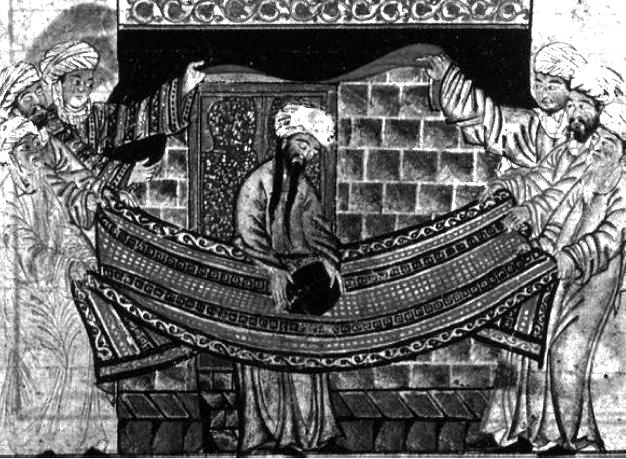 Rebuilding the Ka’aba
Rebuilding the Ka’aba
When Muhammad was 35 years old, the citizens of Mecca decided to rebuild the Ka’ba, making the walls higher, and adding a roof and gates. During the rebulding process a question arose as to who should have the honor of raising the Black Stone into its proper place. The Black Stone was a large meteorite that had fallen to earth many centuries before and had been revered by the Nabataeans in Petra as a representative of the god Al Dushares, the god of rocks and mountains. Each tribe claimed the honor of raising the stone, so an argument broke out. A respected senior citizen advised the disputants to allow the gods to choose a man. He suggested that it be the first man to enter the Ka'ba gate. The proposal was agreed upon, and the first man who entered the gate was Muhammad. His advice then satisfied all the contending parties. He ordered the stone to be placed on a piece of cloth and each tribe to share the honor of lifting it up by taking hold of a part of the cloth. In this manner the stone was deposited in its place and Muhammad recognized that he was chosen of God for something special. (Taken from Ibn Ishaq 125-126)
At 40 years of age, Muhammad decided to follow the pagan practice of Tahannuth, where a person would go into the mountains in seclusion for one month to meditate. So he went to nearby Mount Hira. One night the figure of an angel appeared to him holding an ornate cloth and commanded him to read. Muhammad answered “What shall I read?” The figure pressed it to him so tight that Muhammad thought he would die. “Read” he was commanded again. “What shall I read” “Read” he was commanded a third time. “What shall I read” Muhammad begged in terror. “Read: in the name of the Lord who created man of blood coagulated. Read! The Lord is the most beneficent, Who taught by the pen, Who taught that which they knew not, unto men.” Muhammad then awoke from his sleep and the words would not leave him. This terrified him, and he later said "I was afraid that I was possessed by a demon. None of God’s creatures were more hateful to me than a man possessed; I could not even look at them. I thought: Woe is me. Never shall the Quraysh say this of me. I will go to the top of the mountain and throw myself down that I may kill myself and gain rest.” So Muhammad began to climb the mountain. About midway up he heard a voice speaking “Oh Muhammad, you are the apostle of God and I am the angel Gabriel.” Where ever Muhammad looked, Gabriel stood in front of him, so he could not climb higher. Eventually Muhammad gave up and returned back to Mecca where he collapsed in his wife’s lap and asked her to cover him for he was sick. He then confessed to her that he might be demon possessed. She tried to comfort him. Several days later Khadija came to Muhammad with a request. “When the angel Gabriel comes to you, can you speak and talk to people?” “Yes” “The next time you see him, can you call me?” Several days later Muhammad said to Khadija “I see Gabriel” “Get up and sit on my left leg” She commanded. He did so. “Can you see him” When Muhammad confirmed this she asked him to sit on her right leg. Gabriel was still there. Then she had him sit on her lap. The whole while Muhammad could still see Gabriel. Then she stripped herself of her clothing. “Can you still see him?” “No” he replied. Oh Muhammad!” she exclaimed “He is an angel and not a demon for he withdrew when I exposed myself. This is an ancient test which I learned from my mother.” Muhammad accepted the test and from this point on never questioned Gabriel’s authenticity. (Taken from Ibn Ishaq 152-154)
During one of his revelations in the local temple, Muhammad uttered Sura 53:19-20 “Have you then considered Lat and Uzza and another, the third, Manaat?” Here Muhammad concedes that the people could continue to worship the Nabataean god of power, and the goddess of fate and and the goddess fertility. There are some Traditions that say that this verse was originally followed by “…whose intercession may be counted on.” When the people of Mecca heard this they were greatly pleased at the way in which Muhammad spoke of their gods. Muhammad then prostrated himself, facing north as was his custom, and many of the people of Mecca joined him. After their time of prayer they said “Muhammad has spoken of our gods in a splendid fashion.” Eventually news reached those in Africa that the people of Mecca had accepted Muhammad’s teaching and they decided to return. Upon their return they were shocked at the teachings of Muhammad. Muhammad then repented of what he said, claiming that Satan had put the words into his mouth. According to the Qur’an, the angel Gabriel came and chastised him for his compromise. The Qur'an says “And we never sent a messenger or a prophet before thee but when he desired, the devil made a suggestion respecting his desire, but Allah annuls that which the devil casts, then does Allah establish His messages, and Allah is knowing, wise.” (Taken from Ibn Ishaq 239-240) From this we learn about the Muslim concept of abrogation, or the canceling of one revelation through further revelation. This was later applied to the teachings of the Old and New Testament when Muslims claimed that the Qur’an replaced them.
The Hijra (هِجْرَة) is the migration or journey of the Islamic prophet Muhammad and his followers from the Holy City (Mecca) to Medina in 622 CE. Alternate spellings of this Arabic word are Hijrah, Hijrat or Hegira, the last following the spelling rules of Latin. This event begins the Islamic calendar, as Islam was finally established as a ruling power in a specific location rather than an individual's personal belief. This demonstrates the difference between an Islamic view of Islam and a western view. (i.e. a ruling religion versus a personal religion)
The Mosque of the Prophet which would later be called al-Madina al- Munawara, was built in 622 by the Muslim community after they reached the city of Yathrib. This mosque was situated next to the prophet’s house, and it consisted of a square enclosure of thirty by thirty-five meters, built with palm trunks and mud walls. It was accessed through three doors, Bab Rahmah to the south, Bab Jibril to the west and Bab al-Nisa’ to the east. Within this enclosure, the prophet created a shaded area to the south called the suffrah and aligned the prayer space facing north towards Syria (Petra). Seven years later, the mosque was doubled in size to accommodate the increasing number of Muslims. After the death of the prophet, the mosque was again enlarged to twice its size. In 707 AD, Umayyad Caliph al-Walīd (705-715) tore down the old structure in order to build a larger mosque measuring eighty-four by one hundred meters. This structure had a stone foundation and a teak roof supported on stone columns. The new mosque included the house of the Prophet under which he was buried. Because the mosque has undergone such extensive renovations at multiple times, it is impossible to make out the original floor plan, the original direction of prayer, and when the qibla changed.
Masjid al-Qiblatain (Mosque of the two qiblas) is a mosque in Medina that is historically important for Muslims, as it is remembered as the place where a companion leading the prayer was told of the change of qibla. He did a 180 degree turn and he is said to have been commanded to change the direction of prayer (qibla). Later Islamic writers claim this was a change from Jerusalem to Mecca. Archeological records demonstrate that the original qiblas used at this time were towards Petra, and that the change happened many years later. This mosque uniquely contains two prayer niches (miḥrabs). This is an important mosque for our study as the original structure was built around 626 AD and further renovations maintained the original qibla. In 1987 the mosque was completely renovated, removing the old prayer niche that faced north, but maintaining the one facing Mecca. The mosque has undergone several major reconstructions, the latest being in 1987. Nothing remains of the original mosque, but ’Abdel Wahed el Wakil, an architect, made excellent drawings of the earlier structures before the mosque was torn down and replaced with the new building. A report of his work can be found on the internet at: http://www.archnet.org/library/files/one-file.jsp?file_id=946. When the old mosque was torn down, the foundation stones of the earlier mosque revealed that the original building faced north towards both Petra and Jerusalem which were in almost exactly the same direction.
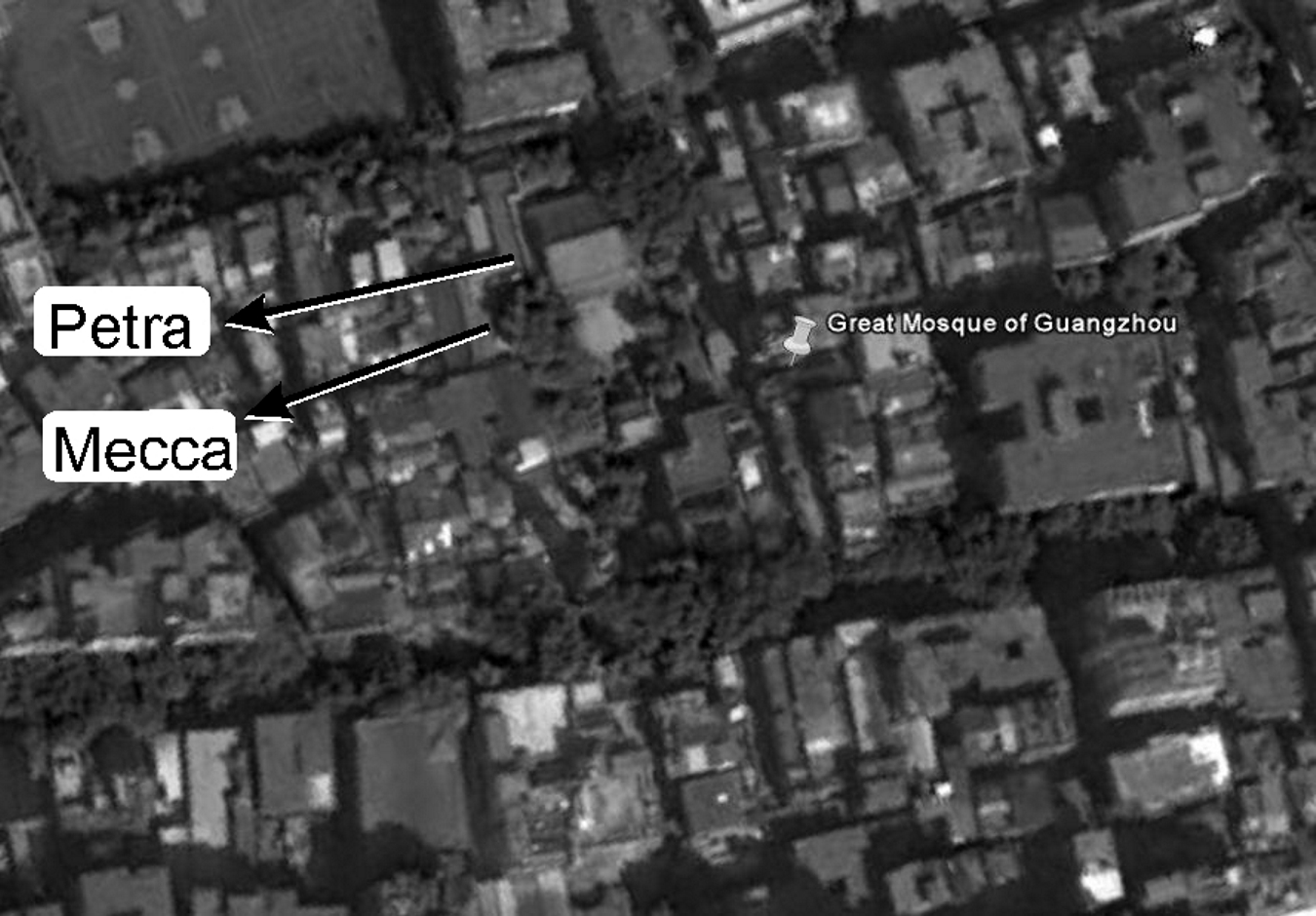 The Great Mosque of Guangzhou, known also as Huaisheng Mosque (Memorial of the Holy Prophet) or the Guangta Mosque (Light Tower Mosque) is thought to be the earliest surviving mosque in China, and has the earliest freestanding minaret in China. Manuscripts from 1206 claim that the mosque was originally built by an uncle of the Prophet, Abū Waqqās, on the first Muslim mission to China in the 630’s, during Muḥammad’s lifetime. The mosque was then rebuilt in 1350 during the Yuan dynasty under the rule of Zhizheng (1341-1368), and rebuilt again in 1695 under Emperor Kangzi of the Qing dynasty after it was destroyed in a fire. The Huaisheng Light Tower, the mosque’s unique namesake minaret, was built at an earlier period. Like its contemporaries at Quanzhou, Hangzhou and Yangzhou, the Great Mosque of Guangzhou is notable for its integration of the local Han building tradition with imported Arab styles. Gibson examined this mosque and found it very difficult to determine if the builders rebuilt on the original foundations. This mosque faces 12 degrees north of where the Mecca qibla is, meaning that it directly faces Petra. Because of its great distance from Arabia, local Muslims feel that it is close enough to Mecca. (Note: Gibson spends a great deal of time explaining the various connections between Arabia and China in chapter 21 of his book Qur'anic Geography).
The Great Mosque of Guangzhou, known also as Huaisheng Mosque (Memorial of the Holy Prophet) or the Guangta Mosque (Light Tower Mosque) is thought to be the earliest surviving mosque in China, and has the earliest freestanding minaret in China. Manuscripts from 1206 claim that the mosque was originally built by an uncle of the Prophet, Abū Waqqās, on the first Muslim mission to China in the 630’s, during Muḥammad’s lifetime. The mosque was then rebuilt in 1350 during the Yuan dynasty under the rule of Zhizheng (1341-1368), and rebuilt again in 1695 under Emperor Kangzi of the Qing dynasty after it was destroyed in a fire. The Huaisheng Light Tower, the mosque’s unique namesake minaret, was built at an earlier period. Like its contemporaries at Quanzhou, Hangzhou and Yangzhou, the Great Mosque of Guangzhou is notable for its integration of the local Han building tradition with imported Arab styles. Gibson examined this mosque and found it very difficult to determine if the builders rebuilt on the original foundations. This mosque faces 12 degrees north of where the Mecca qibla is, meaning that it directly faces Petra. Because of its great distance from Arabia, local Muslims feel that it is close enough to Mecca. (Note: Gibson spends a great deal of time explaining the various connections between Arabia and China in chapter 21 of his book Qur'anic Geography).
According to many early authorities (e.g. Bukhari's Hadith 3.786, 5:59:713), Muhammad was poisoned. His death is set around 8 June 632 (in 11 AH). Muslims then began to split into two groups, Sunni and Shi’a. Sunnis assert that even though Muhammad never appointed a successor, Abu Bakr was elected first caliph by the Muslim community and insist that all of the rulers of the new Islamic empire should be elected. The Sunnis recognize the first four caliphs as Muhammad's rightful successors. This was followed by the Umayyads ruling from Damascus. The Shi’as however believe that Muhammad explicitly named his successor asAli. This led to the first civil war.
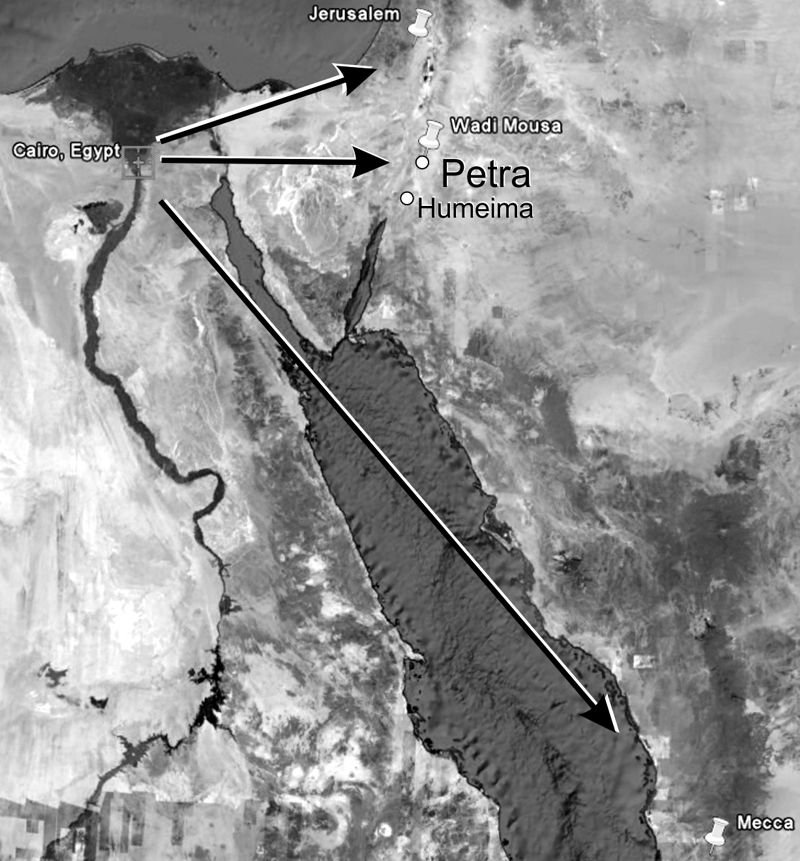 The Mosque of ’Amr ibn al-’As was founded by the Muslim conqueror of Egypt in 641 near his house in the town of Fusṭāṭ, outside of Cairo. This mosque was rebuilt and enlarged in 673 during the reign of Mu’āwiya, who is said to have added a minaret to each of its four corners. Today the mosque does not exist in its original form, having undergone numerous restorations so that the original foundation is no longer evident. However, the original ground-plan of the mosque shows that the qibla pointed too far north and had to be corrected later under the governorship of Qurra ibn Sharīk. (Creswell 1969, pages 37,150) Interestingly this agrees with the later Islamic tradition compiled by Aḥmad ibn al-Maqrizi that ’Amr ibn al-’As prayed facing east, and not towards the south.
The Mosque of ’Amr ibn al-’As was founded by the Muslim conqueror of Egypt in 641 near his house in the town of Fusṭāṭ, outside of Cairo. This mosque was rebuilt and enlarged in 673 during the reign of Mu’āwiya, who is said to have added a minaret to each of its four corners. Today the mosque does not exist in its original form, having undergone numerous restorations so that the original foundation is no longer evident. However, the original ground-plan of the mosque shows that the qibla pointed too far north and had to be corrected later under the governorship of Qurra ibn Sharīk. (Creswell 1969, pages 37,150) Interestingly this agrees with the later Islamic tradition compiled by Aḥmad ibn al-Maqrizi that ’Amr ibn al-’As prayed facing east, and not towards the south.
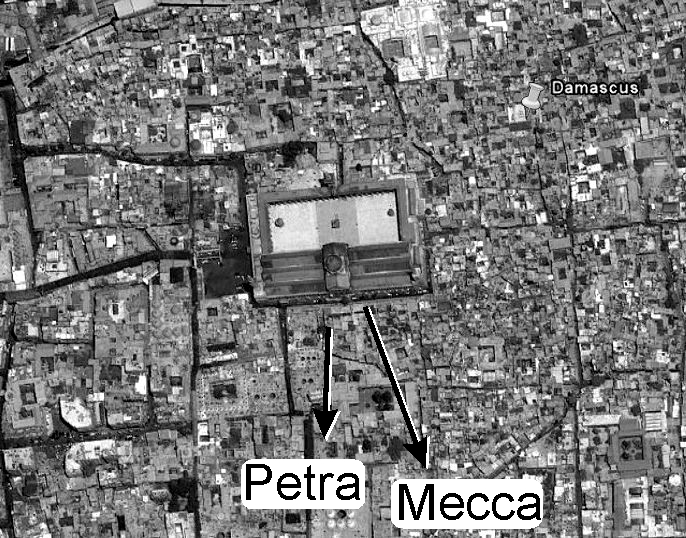 Forty years after the Hijra, or emigration, the Umayyads moved the capital city of the new Islamic Empire to the great old city of Damascus. Suddenly the new Muslim empire was thrust into world history. They were no longer warring tribes from the desert, but now they were a new force for the other empires of the world to deal with.
Forty years after the Hijra, or emigration, the Umayyads moved the capital city of the new Islamic Empire to the great old city of Damascus. Suddenly the new Muslim empire was thrust into world history. They were no longer warring tribes from the desert, but now they were a new force for the other empires of the world to deal with.
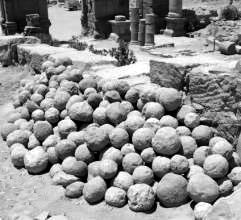
During the civil war with Ibn Zubayr (64 AH, 683 AD) the Syrian army attacked the Holy City, and during the month of October destroyed the Ka’ba in the center of the city with a trebuchet (or catapult) which hurled large stones into the Ka’ba area. (Cosman, 2008, pg 305) (Ṭabarī XIX: 223-224) In the city of Mecca in Saudi Arabia there is no evidence of trebuchet stones ever being used against the city, or even city walls over which a trebuchet would have thrown stones. No evidence of this battle exists in Mecca. In Petra,however, archeologists have uncovered many trebuchet stones which were hurled into the central courtyard in front of the Temple of Dushara. Using the fallen roof tiles from the nearby Great Temple, it is possible to date the fortified area and stones to sometime after the earthquake of 551 AD. The area was covered in rubble from the later earthquake of 713 AD (128 AH). Is it not an amazing coincidence that a tebuchet was used against Petra at exactly the same time as a battle was supposed to be fought against Mecca? Did a later editor simply erase the name of Petra (known as Becca) and replace it Mecca?
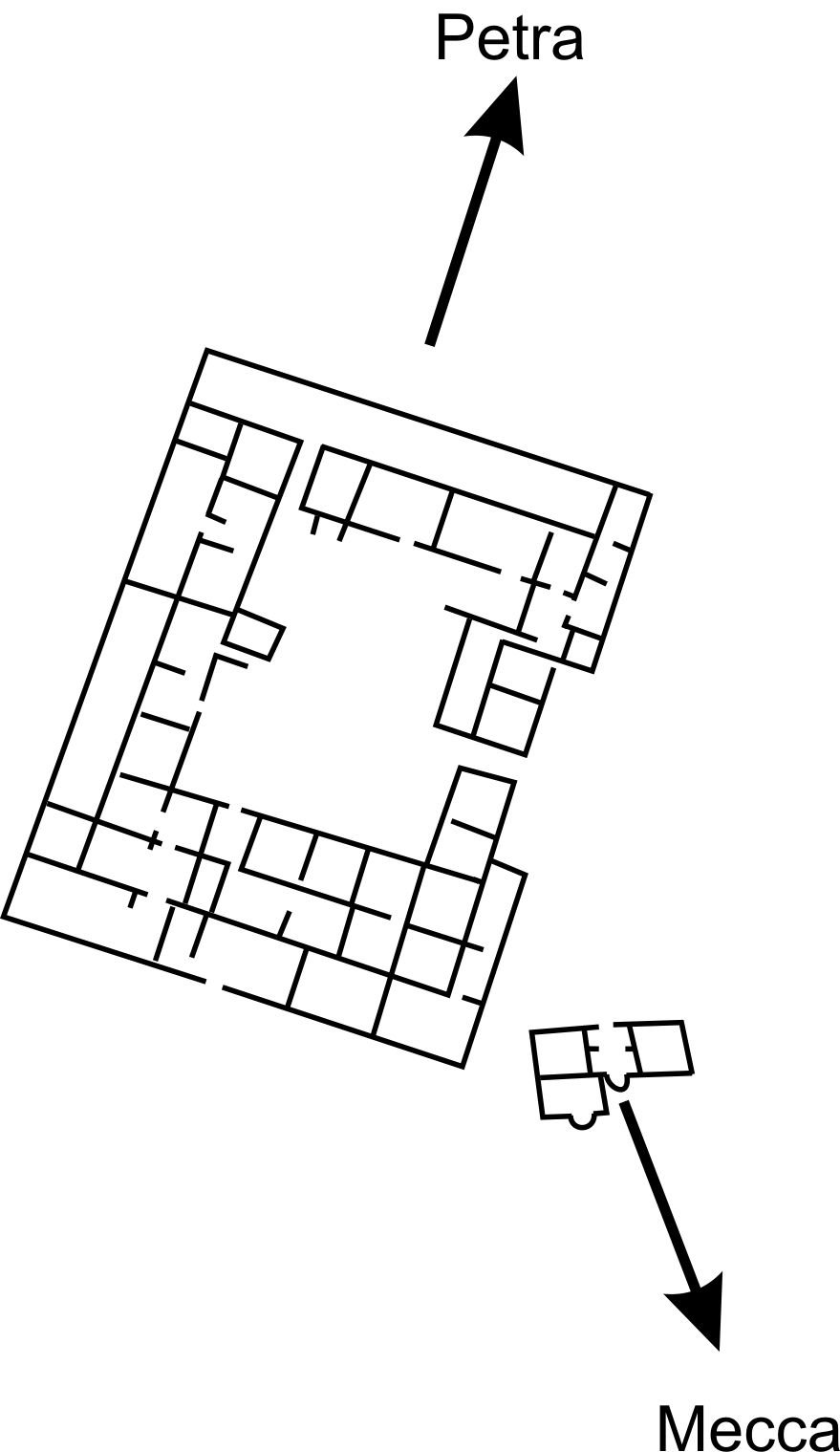
The Abbas Palace (qaṣr) at Ḥumeima was built during the early Islamic era by Alī, a grandson of ’Abbās, a paternal uncle of the prophet Muḥammad. It would have either included a prayer room or the central court would have been used for prayer, therefore the alignment of the entire building should have been according to the qibla. The building is oriented northeast. Mecca is not in this direction, nor is Jerusalem, but it does correspond with Petra, only 27 miles to the north. Later a smaller outside mosque was built with a qibla pointing closer to Mecca. Is it not interesting that Muhammad's relatives lived near Petra, and not Mecca, and that their house was oriented towards Petra?
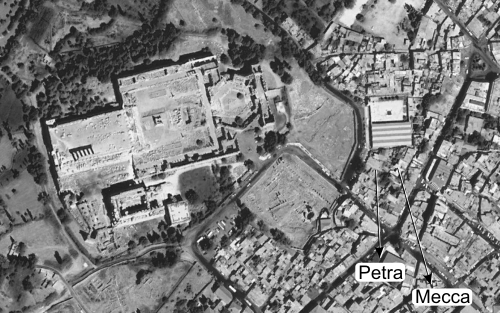 The Great Mosque of Ba’albek in Lebanon is an Umayyad mosque dating back to 81 AH. It has suffered from deterioration due to dampness, salt, and structural degradation. The last renovation was conducted with special attention to archaeological remains, as it is believed that the mosque may have been built upon several older structures dating back to antiquity. Lime mortar and traditional materials were used to preserve the building’s character. The Ba’albek Mosque (to the right of the main Ba’albek ruins in the photo in Qur'anic Geography) has an orientation closer to Petra than to Mecca.
The Great Mosque of Ba’albek in Lebanon is an Umayyad mosque dating back to 81 AH. It has suffered from deterioration due to dampness, salt, and structural degradation. The last renovation was conducted with special attention to archaeological remains, as it is believed that the mosque may have been built upon several older structures dating back to antiquity. Lime mortar and traditional materials were used to preserve the building’s character. The Ba’albek Mosque (to the right of the main Ba’albek ruins in the photo in Qur'anic Geography) has an orientation closer to Petra than to Mecca.
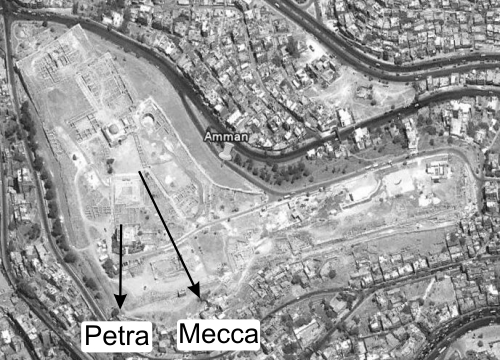 The first Islamic buildings on the Amman, Jordan citadel were built around 700 AD. They are the lower buildings in the photo. So far, it has not been possible to absolutely date the time of construction of these buildings, but they were built early during Umayyad rule. However if you examine the photo you can clearly see that the first set of buildings (lower left) pointed south towards Petra. The later buildings were built around 740 AD (above the earlier buildings) and clearly demonstrate a new focus and direction. The original buildings faced Petra, but the newer buildings (built some 40 years later) face Mecca. During the period between these two constructions was the Second Civil War when ’Abdallah ibn Zubayr completely destroyed the Ka’ba and rebuilt it, possibly in a new location.
The first Islamic buildings on the Amman, Jordan citadel were built around 700 AD. They are the lower buildings in the photo. So far, it has not been possible to absolutely date the time of construction of these buildings, but they were built early during Umayyad rule. However if you examine the photo you can clearly see that the first set of buildings (lower left) pointed south towards Petra. The later buildings were built around 740 AD (above the earlier buildings) and clearly demonstrate a new focus and direction. The original buildings faced Petra, but the newer buildings (built some 40 years later) face Mecca. During the period between these two constructions was the Second Civil War when ’Abdallah ibn Zubayr completely destroyed the Ka’ba and rebuilt it, possibly in a new location.
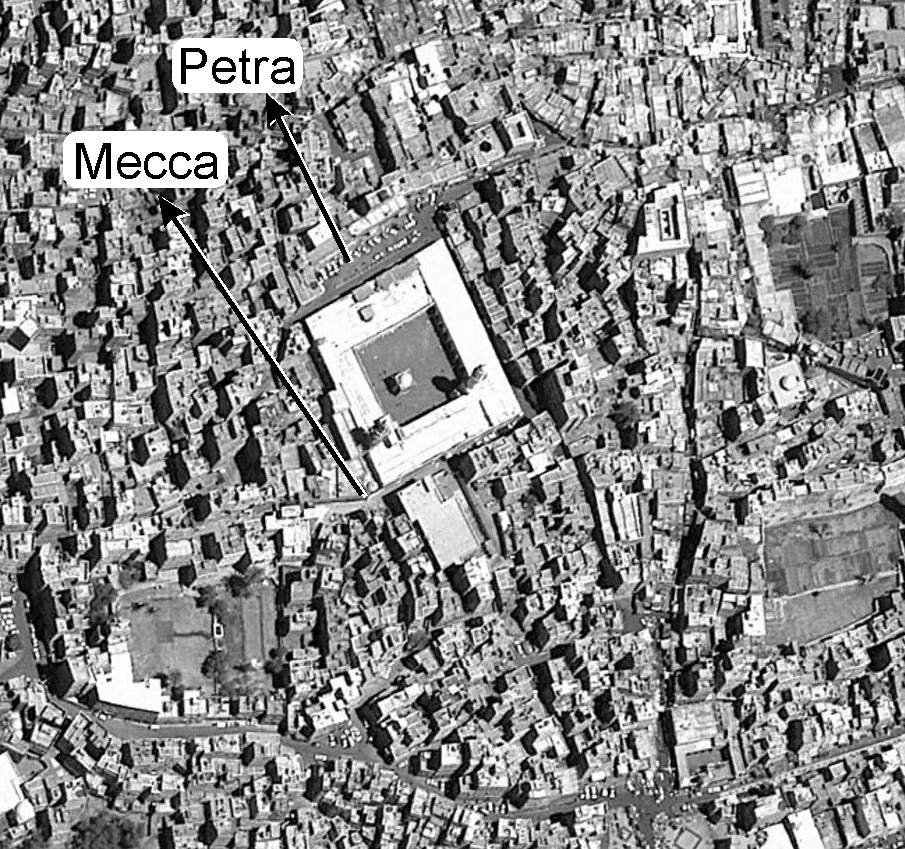 The Great Mosque of Ṣan’ā is in the capital city of Yemen. According to early sources, the Prophet Muḥammad commanded the construction of this mosque, including its location and dimensions, sometime around 630 AD. While the validity of this claim lacks certainty, the mosque remains one of the early architectural projects in Islam. Sometime between 705 and 715 AD, the Umayyad Caliph al-Walīd I rebuilt and enlarged the mosque. Like the previous examples, this mosque points towards Petra, but since it is south of Mecca it could be argued that it also points in the general direction of Mecca. In 1972 and 2010, caches of early versions of the Qur'ān were discovered in this mosque that greatly impact our study and are presented in the timeline on the development of the Qur'ān.
The Great Mosque of Ṣan’ā is in the capital city of Yemen. According to early sources, the Prophet Muḥammad commanded the construction of this mosque, including its location and dimensions, sometime around 630 AD. While the validity of this claim lacks certainty, the mosque remains one of the early architectural projects in Islam. Sometime between 705 and 715 AD, the Umayyad Caliph al-Walīd I rebuilt and enlarged the mosque. Like the previous examples, this mosque points towards Petra, but since it is south of Mecca it could be argued that it also points in the general direction of Mecca. In 1972 and 2010, caches of early versions of the Qur'ān were discovered in this mosque that greatly impact our study and are presented in the timeline on the development of the Qur'ān.
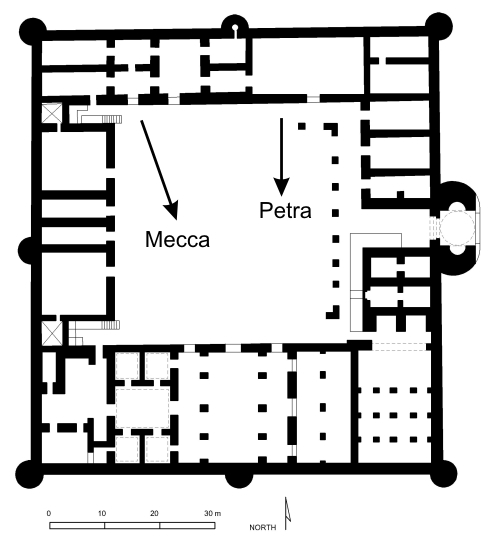 Qaṣr Khirbat al Minya is in Israel (also known as ’Ayn Minyat Ḥishām). This is an Umayyad-built palace located in the eastern Galilee region about 200 meters (660 ft) west of the northern end of Lake Tiberias. It was erected as an Umayyad palace complex with a palace, mosque and bath, built by al Walīd. (The date of construction is based on an inscription set into a gateway) The palace contained a room that was constructed for the purpose of being a mosque. It was the room with pillars in the bottom right corner. Because it is almost directly north of Petra, the mosque and the entire building points directly at Petra, not Mecca which is southeast. The original layout of the buildings can be obtained from www.archnet.org.
Qaṣr Khirbat al Minya is in Israel (also known as ’Ayn Minyat Ḥishām). This is an Umayyad-built palace located in the eastern Galilee region about 200 meters (660 ft) west of the northern end of Lake Tiberias. It was erected as an Umayyad palace complex with a palace, mosque and bath, built by al Walīd. (The date of construction is based on an inscription set into a gateway) The palace contained a room that was constructed for the purpose of being a mosque. It was the room with pillars in the bottom right corner. Because it is almost directly north of Petra, the mosque and the entire building points directly at Petra, not Mecca which is southeast. The original layout of the buildings can be obtained from www.archnet.org.
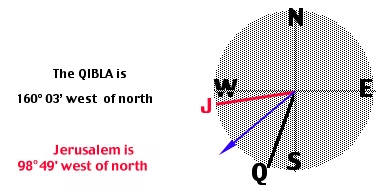 The Wasiṭ Mosque in Iraq has been the center of much discussion. Originally, Creswell and Fehervari studied the ground plans of this mosque and claimed that this mosque pointed to Jerusalem. (Creswell, 1969 pg 137 & 1989, pg 40; Fehervari, 1961, pg 89; Crone-Cook 1977, pgs 23 & 173) However, further research has shown that this mosque does not point to Mecca or Jerusalem, but somewhere in between. In their Internet article Islamic Awareness, The Qibla of Early Mosques, Jerusalem or Makkah? M S M Saifullah, Muḥammad Ghoniem, ’Abd al Raḥmān, Robert Squires and Manṣūr Ahmed clearly demonstrate that the qibla of the Wasiṭ mosque points to neither Jerusalem (too far north) or Mecca (too far south). Instead they discovered that the qibla pointed 155°02’ of north (which is towards the Petra region.) The illustration to the right was taken from their internet article, and demonstrates the direction of the Wasiṭ Mosque qibla.
The Wasiṭ Mosque in Iraq has been the center of much discussion. Originally, Creswell and Fehervari studied the ground plans of this mosque and claimed that this mosque pointed to Jerusalem. (Creswell, 1969 pg 137 & 1989, pg 40; Fehervari, 1961, pg 89; Crone-Cook 1977, pgs 23 & 173) However, further research has shown that this mosque does not point to Mecca or Jerusalem, but somewhere in between. In their Internet article Islamic Awareness, The Qibla of Early Mosques, Jerusalem or Makkah? M S M Saifullah, Muḥammad Ghoniem, ’Abd al Raḥmān, Robert Squires and Manṣūr Ahmed clearly demonstrate that the qibla of the Wasiṭ mosque points to neither Jerusalem (too far north) or Mecca (too far south). Instead they discovered that the qibla pointed 155°02’ of north (which is towards the Petra region.) The illustration to the right was taken from their internet article, and demonstrates the direction of the Wasiṭ Mosque qibla.
Immediately after Zubayr’s rebellion and consequent rebuilding of the Ka’ba, the Miḥrab mark or niche was introduced. It is said that during the reign of the ’Uthmān ibn Affan (644-656), the caliph ordered a sign to be posted on the wall of the mosques at Medina so that pilgrims could now easily identify the direction in which to address their prayers. This seems to be a strange development, since up until this time the faithful would always face the qibla wall to pray. The entire building faced the qibla, which was Petra. Now, however, a sign was provided in older mosques, seeming to indicate that a new qibla had been introduced. It is most interesting to notice that the miḥrab niche was developed in new mosques soon after this. Evidently since there was confusion over which way to pray, older mosques first used a sign and then began adding amiḥrab so that the faithful could pray in the new direction.
During the reign of Al-Walīd ibn ’Abd al-Mālik (Al-Walīd I, 705-715), the Mosque of the Prophet (the Masjid al Nabawi) was renovated and the governor (wali) of Medina, ’Umar Ibn ’Abdul Azīz, ordered that a niche be made to designate the qibla. ’Uthmān’s sign was then placed inside this niche. Eventually, the niche came to be universally understood as identifying the qibla direction, and so came to be adopted as a feature in other mosques. A sign was no longer necessary.
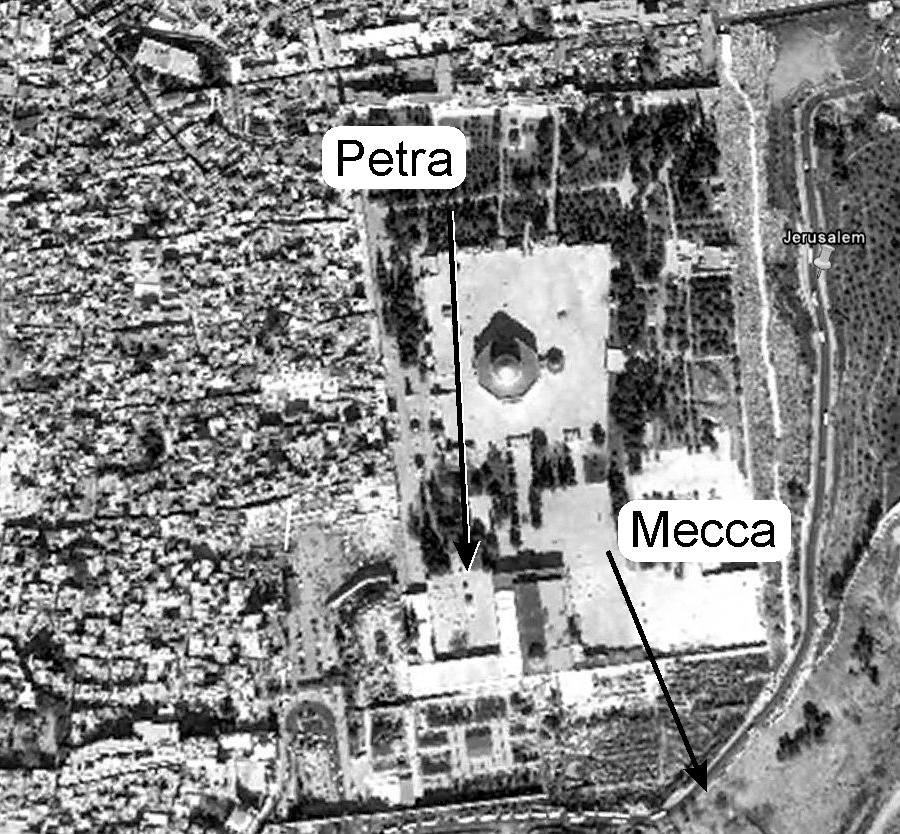 The Al Aqṣa Mosque in Jerusalem has undergone multiple stages of construction and renovations over the years. It is generally agreed that ’Abd al- Mālik, (685-705) the Umayyad Caliph who was the patron of the Dome of the Rock, started the construction of al-Aqṣa Mosque at the end of the 7th century. A major building phase took place during the time of the caliphate of his son, al-Walīd (709-715). The building suffered from several major earthquakes and was renovated and reconstructed during the Abbāsid period by Caliph al-Mahdī (775-785), and possibly by Caliph al-Manṣūr (754-775). This mosque in Jerusalem does not point to Mecca but rather points 169.23° which is towards Petra, only 160 miles away. The Al Aqṣa mosque is located on the bottom center of the photo just below the arrow indicating the direction of Petra. None of the buildings on the Jerusalem citadel point towards Mecca.
The Al Aqṣa Mosque in Jerusalem has undergone multiple stages of construction and renovations over the years. It is generally agreed that ’Abd al- Mālik, (685-705) the Umayyad Caliph who was the patron of the Dome of the Rock, started the construction of al-Aqṣa Mosque at the end of the 7th century. A major building phase took place during the time of the caliphate of his son, al-Walīd (709-715). The building suffered from several major earthquakes and was renovated and reconstructed during the Abbāsid period by Caliph al-Mahdī (775-785), and possibly by Caliph al-Manṣūr (754-775). This mosque in Jerusalem does not point to Mecca but rather points 169.23° which is towards Petra, only 160 miles away. The Al Aqṣa mosque is located on the bottom center of the photo just below the arrow indicating the direction of Petra. None of the buildings on the Jerusalem citadel point towards Mecca.
About this time the qibla wall was changed in the mosque in Medina, under the authority of ’Abd al-Mālik who said it must be changed even if people argue against it. (Ṭabarī 23, pg 141)
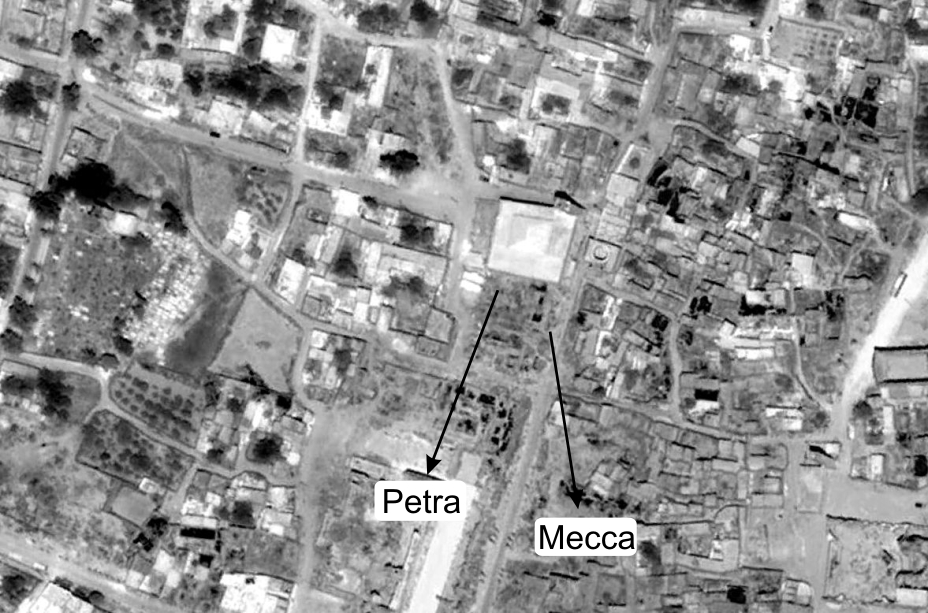 The Mosque of ’Umar is located in the ancient Nabataean city of Bosra, about 140 km south of Damascus. Although Bosra is known for its famous, still-intact theatre, the city also displays strong Islamic (especially Ayyūbid) architectural influences. Some of its Islamic monuments include: Hammam Majak, Mosque of al-Khiḍer, Mabrak Mosque, Fāṭima Mosque and the Mosque of ’Umar. Caliph ’Umar, who led the Muslim conquest of Syria in 636, founded the mosque. It was completed in 720 AD by the Caliph Yazīd II, and renovated and expanded in the twelfth and thirteenth centuries by the Ayyūbid dynasties who also fortified the theatre and baths. The mosque’s orientation does not point towards Mecca.
The Mosque of ’Umar is located in the ancient Nabataean city of Bosra, about 140 km south of Damascus. Although Bosra is known for its famous, still-intact theatre, the city also displays strong Islamic (especially Ayyūbid) architectural influences. Some of its Islamic monuments include: Hammam Majak, Mosque of al-Khiḍer, Mabrak Mosque, Fāṭima Mosque and the Mosque of ’Umar. Caliph ’Umar, who led the Muslim conquest of Syria in 636, founded the mosque. It was completed in 720 AD by the Caliph Yazīd II, and renovated and expanded in the twelfth and thirteenth centuries by the Ayyūbid dynasties who also fortified the theatre and baths. The mosque’s orientation does not point towards Mecca.
Qaṣr al-Ḥayr al-Gharbī is 37 miles west of Palmyra. The mosque is in the lower left corner of this palace. It played a very small part of the overall plan of the building, and was accessed through several other rooms. Unfortunately, the building is in such a state of ruin that it is almost impossible to accurately determine the direction of the qibla, but the whole complex seems to face closer to Petra than to Mecca.
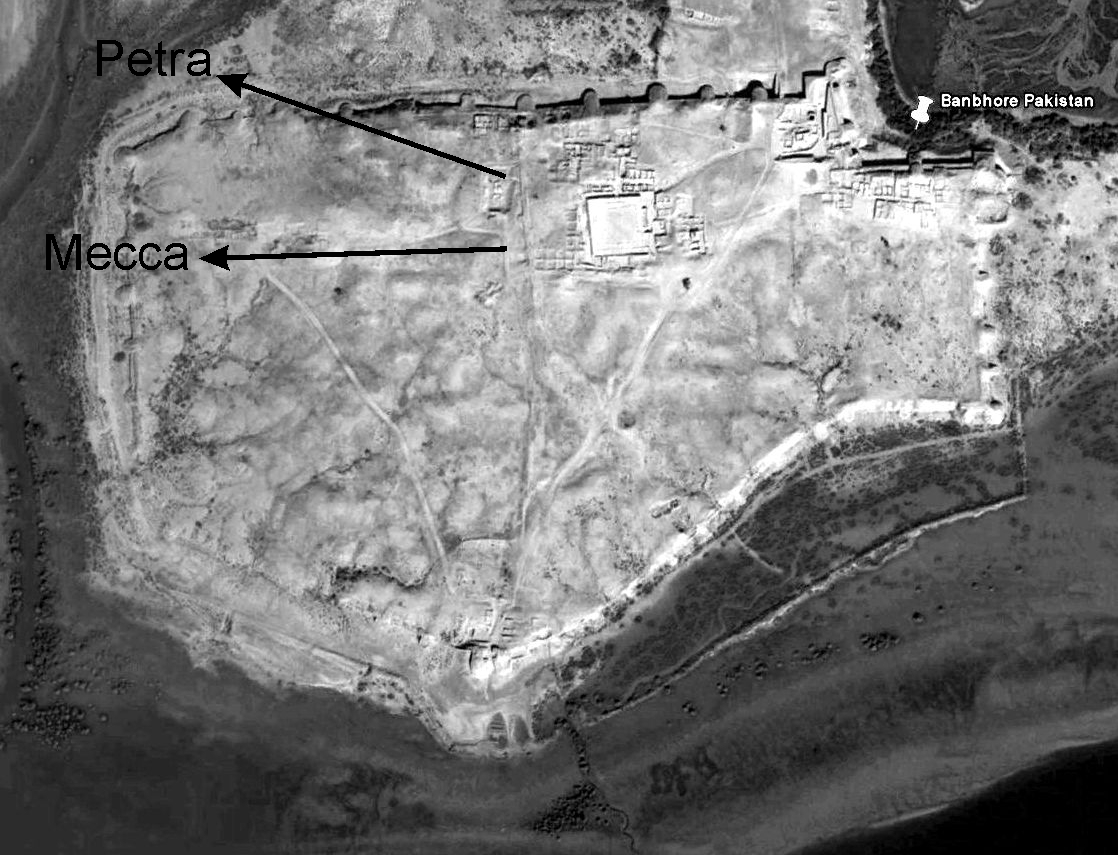 The Mosque in Banbhore, Pakistan is in an area conquered by the Arab general Muḥammad ibn Qāsim in 711 AD. This mosque has a qibla wall, but no miḥrab. The building is oriented east to west. This mosque appears to face Mecca not Petra making it the very first mosque that we can find, that faced only Mecca in Saudi Arabia, (and not also Petra). This mosque was built over 100 years after the founding of Islam!
The Mosque in Banbhore, Pakistan is in an area conquered by the Arab general Muḥammad ibn Qāsim in 711 AD. This mosque has a qibla wall, but no miḥrab. The building is oriented east to west. This mosque appears to face Mecca not Petra making it the very first mosque that we can find, that faced only Mecca in Saudi Arabia, (and not also Petra). This mosque was built over 100 years after the founding of Islam!
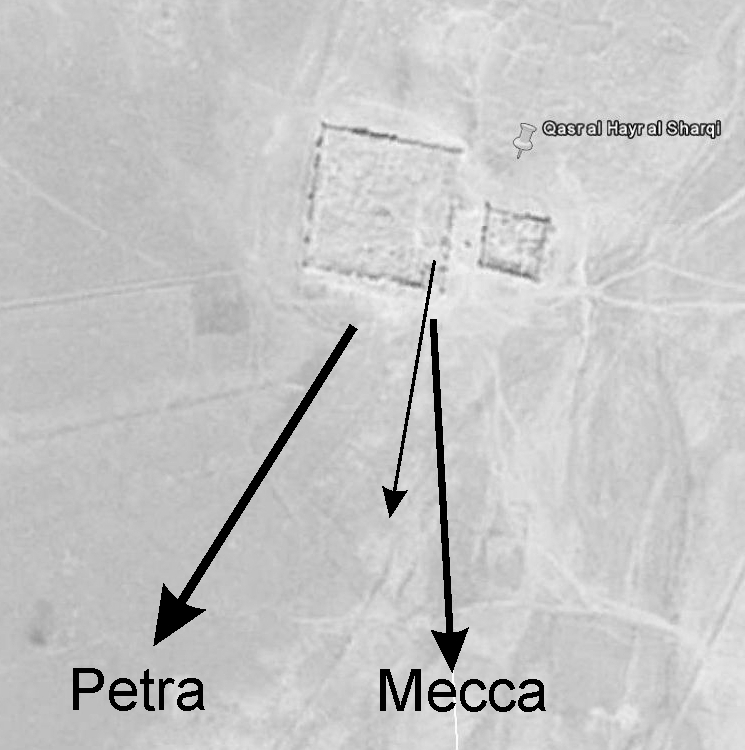 Qaṣr al-Ḥayr al-Sharqī in Syria is approximately 97 km northeast of Palmyra and 64 km to the south of Ruṣafa. It was originally constructed in 728-9 under Caliph Ḥishām to be used as a retreat for the Umayyad caliphs. After Umayyad decline in regional authority, the site was absorbed and embellished by the Abbāsids under caliph Hārūn al-Rashīd and remained functional until the 14th century. The buildings and mosque seem to align to a qibla between Mecca and Petra, as if the builders couldn't decide on which qibla to choose and chose to be neutral.
Qaṣr al-Ḥayr al-Sharqī in Syria is approximately 97 km northeast of Palmyra and 64 km to the south of Ruṣafa. It was originally constructed in 728-9 under Caliph Ḥishām to be used as a retreat for the Umayyad caliphs. After Umayyad decline in regional authority, the site was absorbed and embellished by the Abbāsids under caliph Hārūn al-Rashīd and remained functional until the 14th century. The buildings and mosque seem to align to a qibla between Mecca and Petra, as if the builders couldn't decide on which qibla to choose and chose to be neutral.
 The second set of Umayyad buildings on the Amman Jordan citadel were built round 740 AD. So far, it has not been possible to absolutely date the time of construction of these buildings. The original Umayyad buildings faced Petra (lower left), but the newer buildings faced Mecca. Clearly the qibla changed direction sometime between the construction of these two sets of buildings.
The second set of Umayyad buildings on the Amman Jordan citadel were built round 740 AD. So far, it has not been possible to absolutely date the time of construction of these buildings. The original Umayyad buildings faced Petra (lower left), but the newer buildings faced Mecca. Clearly the qibla changed direction sometime between the construction of these two sets of buildings.
The very first mention of the word "Mecca" appears this year in the Continuatio Byzantia Arabica (Crone-Cook 1977 page 22,171). Before this Mecca did not appear in any literature, nor on any maps of Arabia.
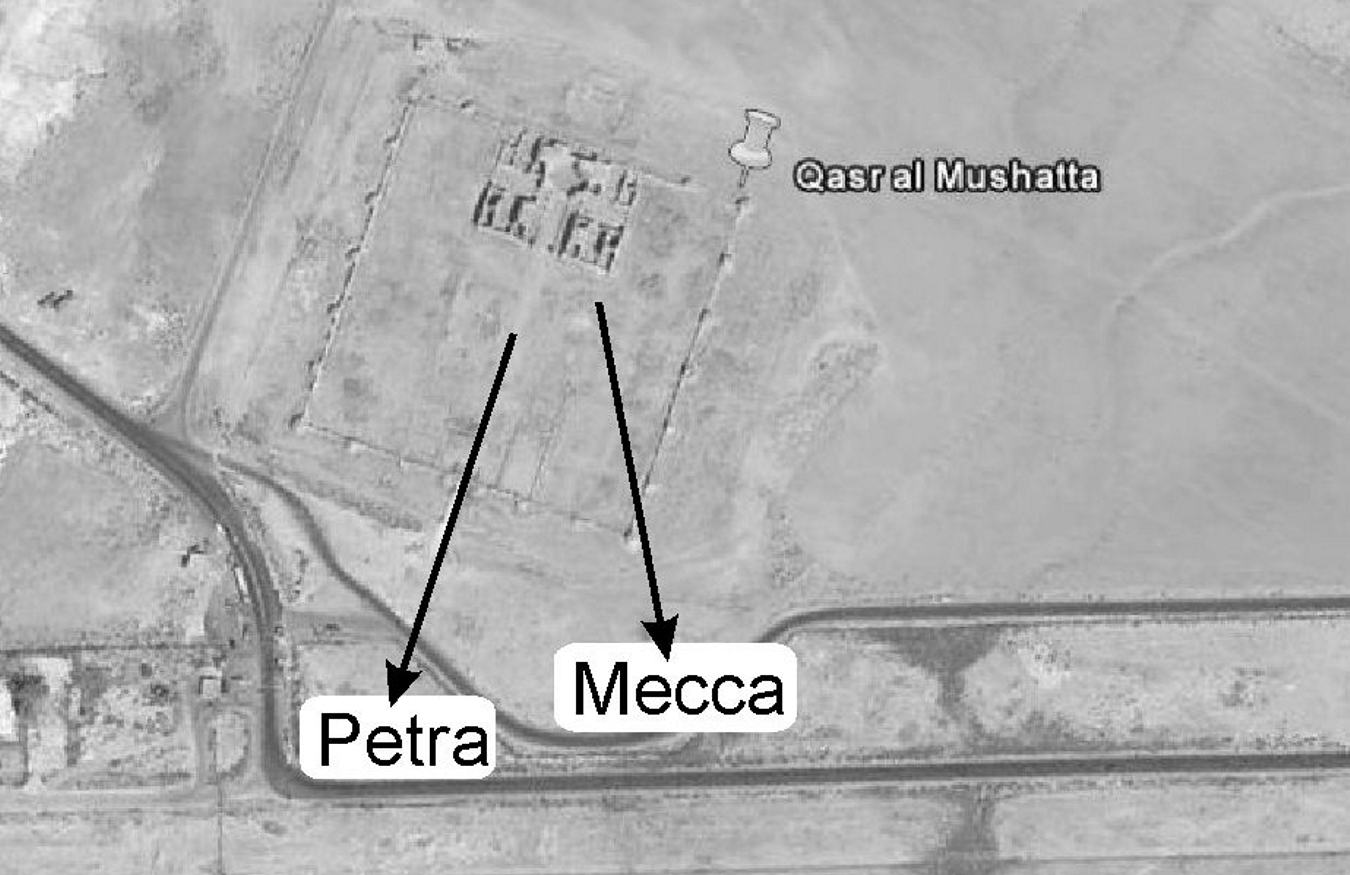 Mushatta Palace and Mosque, 32 km south of Amman Airport. This palace was one of the largest and most impressive of the Umayyad palaces, built of limestone and brick. The mosque is in the southern part of the structure, facing Petra. Indeed the entire complex faces Petra. Qaṣr al-Mushatta became a World Heritage site in 2001.
Mushatta Palace and Mosque, 32 km south of Amman Airport. This palace was one of the largest and most impressive of the Umayyad palaces, built of limestone and brick. The mosque is in the southern part of the structure, facing Petra. Indeed the entire complex faces Petra. Qaṣr al-Mushatta became a World Heritage site in 2001.
There are a number of tragic events that took place at Petra including the following major earthquakes:
- 363 AD – Recorded by Bishop Cyril of Jerusalem (Brock, 1977)
- 551 AD – (Darawcheh, Sbeinati, Margottini, & Paolini, 2000)
- 713 AD – Recorded by Al Ṭabarī XXIII (Hinds, 1990)
There is archeological evidence that these earthquakes caused a great deal of damage. The greatest damage was probably inflicted in 713 AD when not only was Petra affected, but the entire Mediterranean seacoast. Even the mosque in Jericho was destroyed, so much so that it was never rebuilt. (Nur& Burgess, 2008) It may have been that in 713 AD, Petra was finally abandoned since no records of Petra exist after this date.
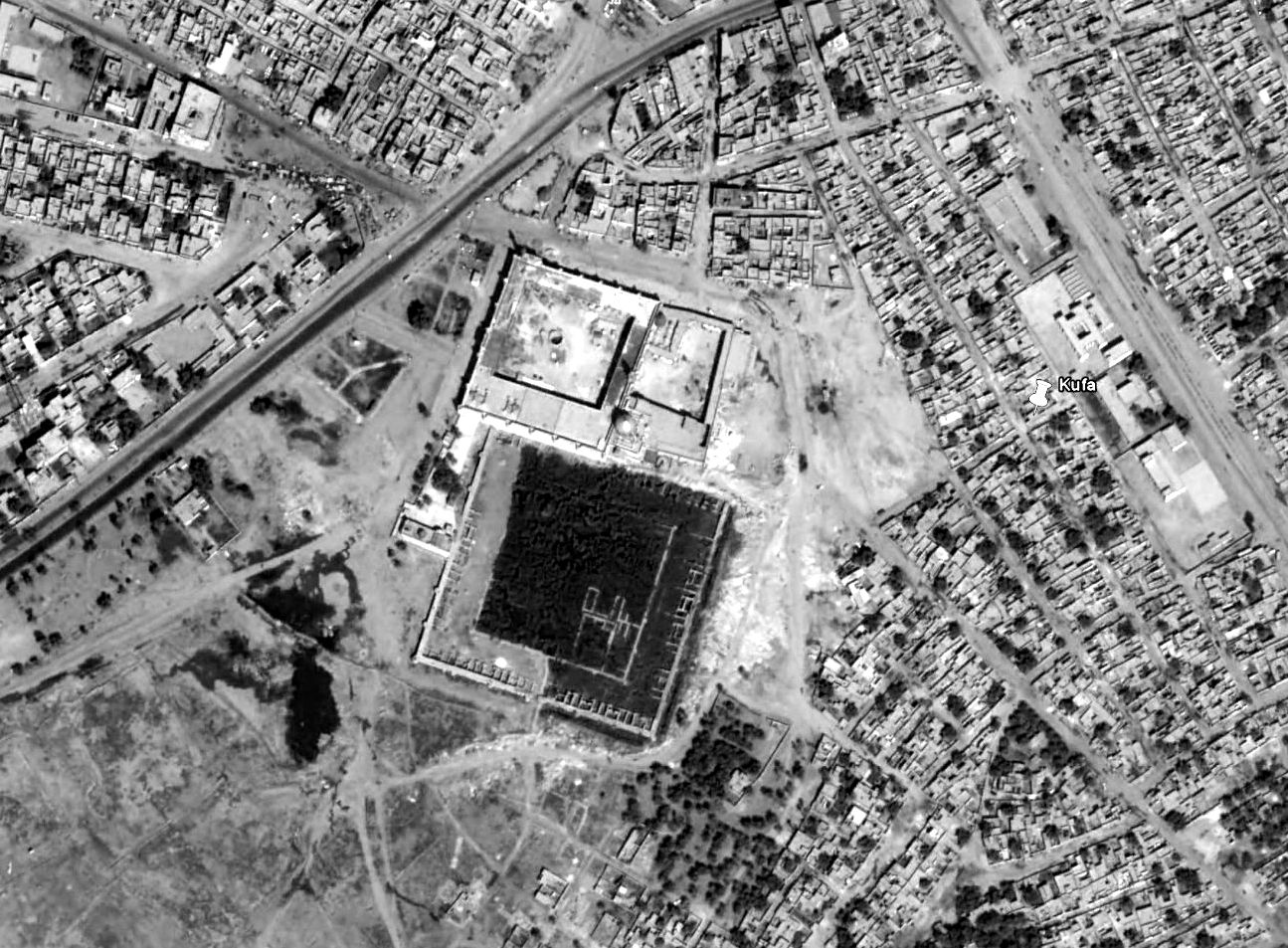 The Second Civil War with the Abbasids taking over the Middle East, leaving the Umayyads in Spain and the far west of North Africa. The Abbasids moved their capital city from Damascus to Iraq, to Kufa, a brand new city constructed for the purpose of being the capital city. Since the the people of Kufa had sided with Ibn Zubayr in the civil war, they adopted Mecca as their Holy City and actively began to promote their version of history, complete with commissioning historians to write histories, and also new "complete" versions of the Qur'an written in Kufic script. Previous to this, all Qur'ans were written in Hijazi or other scripts. All Kufic Qur'ans contain the verses about the Qibla change and mention the city of Mecca by name. These are missing in the Hijazi Qur'ans.
The Second Civil War with the Abbasids taking over the Middle East, leaving the Umayyads in Spain and the far west of North Africa. The Abbasids moved their capital city from Damascus to Iraq, to Kufa, a brand new city constructed for the purpose of being the capital city. Since the the people of Kufa had sided with Ibn Zubayr in the civil war, they adopted Mecca as their Holy City and actively began to promote their version of history, complete with commissioning historians to write histories, and also new "complete" versions of the Qur'an written in Kufic script. Previous to this, all Qur'ans were written in Hijazi or other scripts. All Kufic Qur'ans contain the verses about the Qibla change and mention the city of Mecca by name. These are missing in the Hijazi Qur'ans.
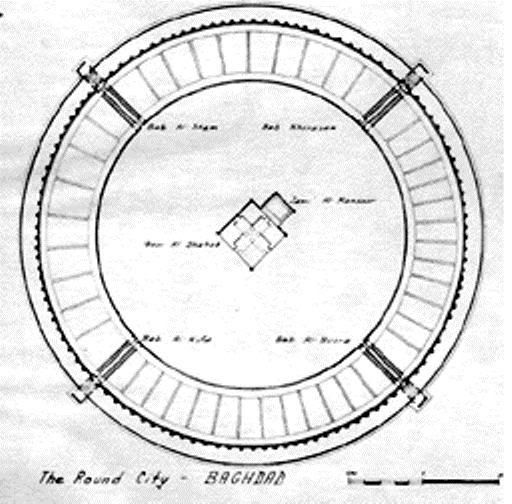 The Mosque of al Manṣūr. In 754, al-Manṣūr became the Abbāsid Caliph, succeeding his brother Saffāh as ruler. By 762 he commissioned the construction of a new eastern capital, choosing Baghdad as his site. The new circular city was designed with ash drawings on the ground for al-Manṣūr to view prior to construction, which began that same year. By its completion in 767 the Round City measured 2 kilometers in diameter. It featured four main gates equally distant from each other: the southwest gate was the Kūfa Gate; the southeast was Baṣra; the Khurāsān Gate extended to the northeast and the Damascus Gate to the northwest. The walls were constructed out of mud brick with reed supports, while the domes and vaults were composed of baked brick. The main mosque of the city was about 100 meters by 200 meters with columns used to support the ceiling around the edges of the mosque. There was no miḥrab, so one wall was used as the qibla wall. This mosque clearly pointed to Mecca.
The Mosque of al Manṣūr. In 754, al-Manṣūr became the Abbāsid Caliph, succeeding his brother Saffāh as ruler. By 762 he commissioned the construction of a new eastern capital, choosing Baghdad as his site. The new circular city was designed with ash drawings on the ground for al-Manṣūr to view prior to construction, which began that same year. By its completion in 767 the Round City measured 2 kilometers in diameter. It featured four main gates equally distant from each other: the southwest gate was the Kūfa Gate; the southeast was Baṣra; the Khurāsān Gate extended to the northeast and the Damascus Gate to the northwest. The walls were constructed out of mud brick with reed supports, while the domes and vaults were composed of baked brick. The main mosque of the city was about 100 meters by 200 meters with columns used to support the ceiling around the edges of the mosque. There was no miḥrab, so one wall was used as the qibla wall. This mosque clearly pointed to Mecca.
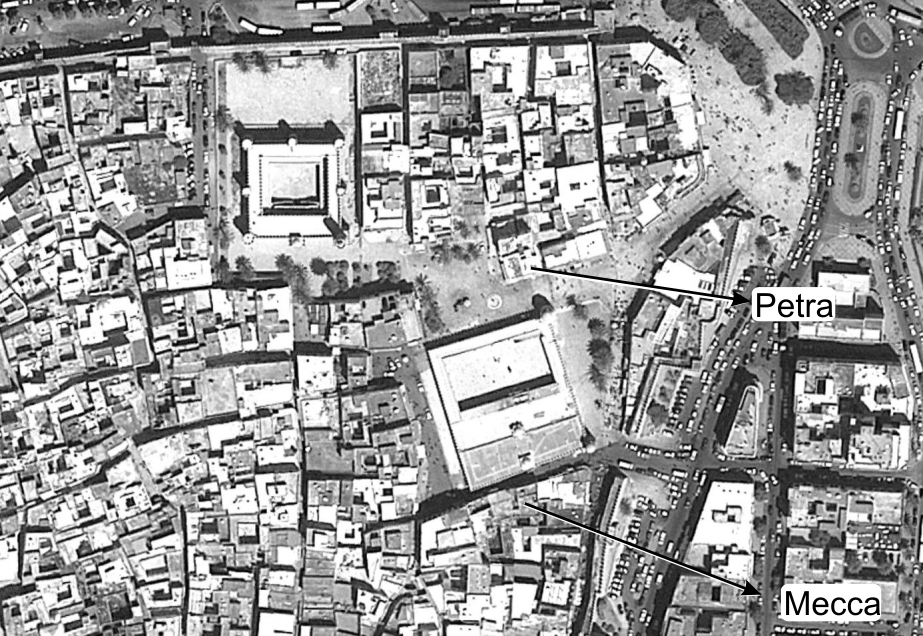
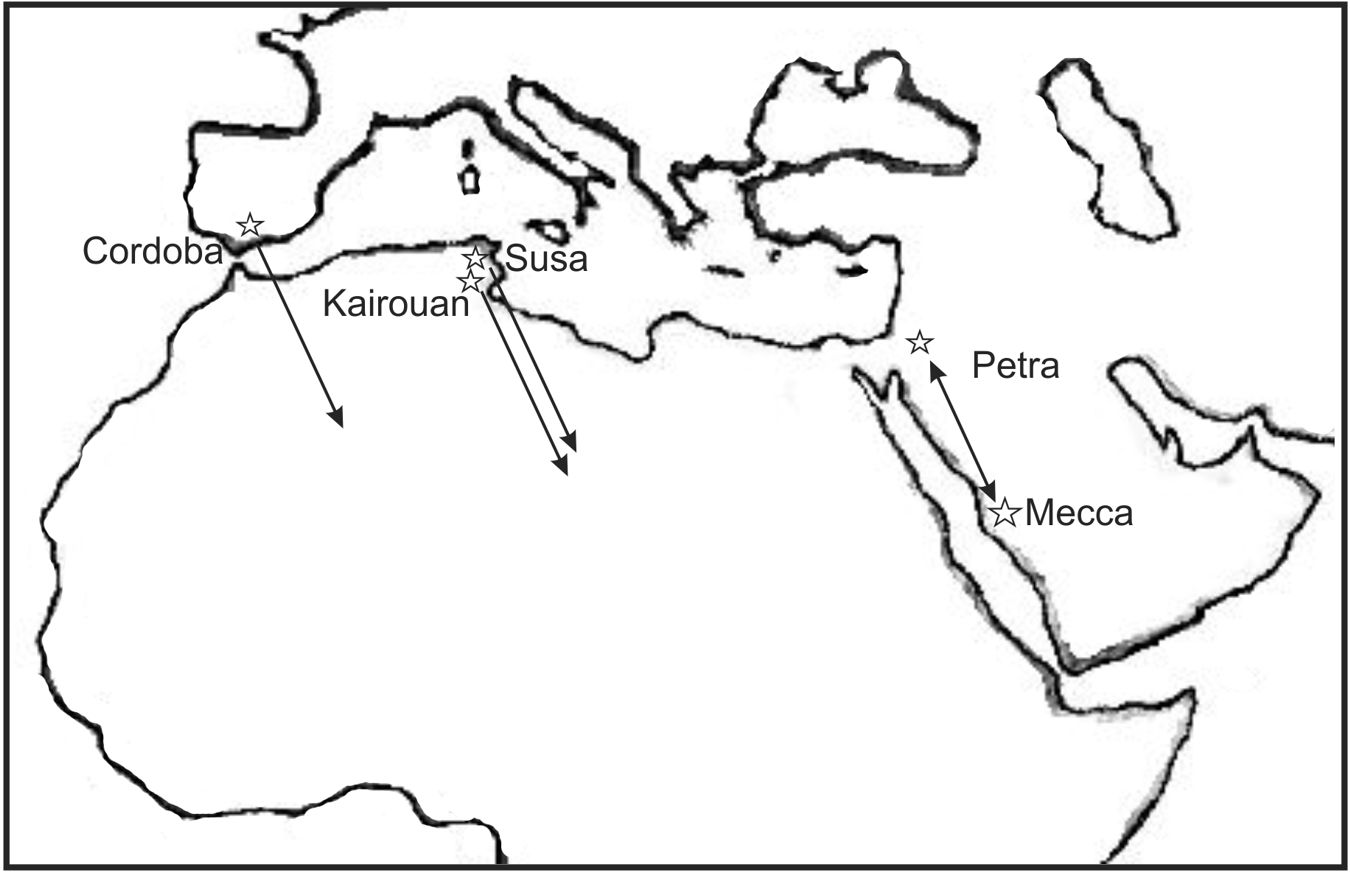
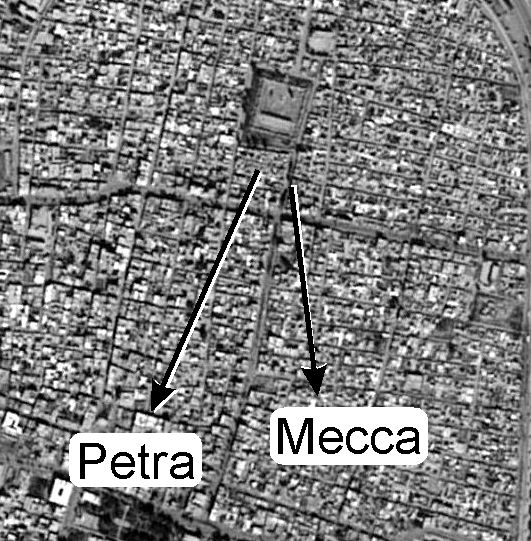
The Great Mosque of Raqqah in Syria is located in the northern section of the city’s heart. Its plan is rectangular (108 meters x 92 meters) with 1.7 meter thick mud brick walls fortified with semi-circular towers at the corners. All that remains today are the baked-brick minaret and prayer hall (ḥaram) facade with eleven arches that were added by Nur al-Din al-Zanki during the 1165 renovation of the mosque. The whole building and complex seems to face between Petra and Mecca.
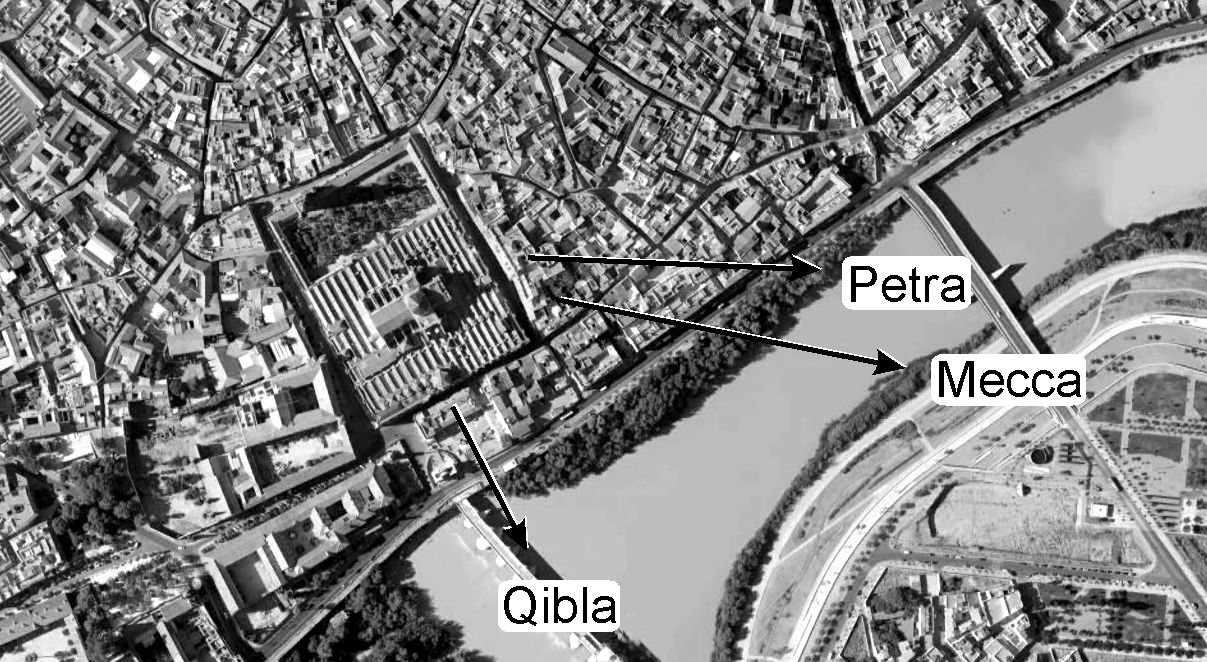

The Great Mosque of Córdoba, Spain was built starting in 784 AD. The qibla of this mosque has puzzled researchers for many years as, like the Susa mosque, it points to neither Mecca nor Petra. Some suspect that since the Umayyad rulers were at odds with the Abbāsid rulers, they refused to use the same qibla (Mecca), and yet felt that they could not point to the original Holy City as the Black Stone was no longer there. In the end, they pointed the mosque south (60 degrees south of east) which was more towards South Africa, just as the Susa mosque was oriented. The last major renovation of this mosque was in 987 AD. For many years this mosque was the second largest in the world. Scholars have often wondered about the direction of the Umayyad qiblas at this time but when they are viewed on a map it is obvious that their qiblas ran parallel to a line drawn between Mecca and Petra.
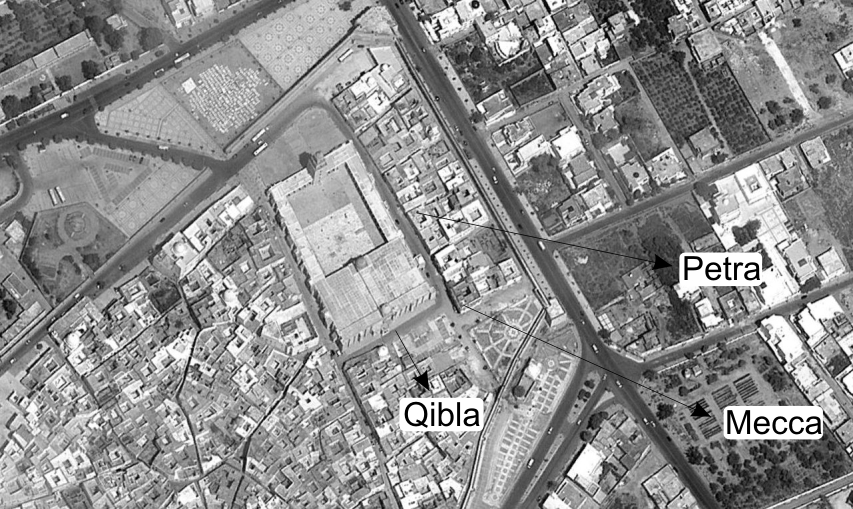

The Great Mosque of Kairouān, Tunisia. As it stands today, this mosque was built by the Aghlabid governor of Kairouān, Ziyādat Allāh, between 817 and 838 AD. He erected the building on the site of an older mosque, originally constructed by ’Uqba ibn Nāfi at the time of the 670 AD Arab conquest of North Africa. Although the current mosque retains virtually no trace of the original seventh-century building, it is still often referred to as “Mosque of Sidi ’Uqba,” or “Mosque of ’Uqba Ibn Nāfi.” Historically, it has been accorded great significance as the first mosque in the first town of Islam in the West. This mosque also points 60 degrees south of East. Scholars have often wondered about the direction of the Umayyad qiblas at this time but when they are viewed on a map it is obvious that their qiblas ran parallel to a line drawn between Mecca and Petra.


The Great Mosque of Susa in Tunisia was built in 850 AD. The Ribat Fort was built to the north and its mosque was oriented towards the south, so when the city mosque was built it was also oriented in the same direction. Scholars have often wondered about the direction of the Umayyad qiblas at this time but when they are viewed on a map it is obvious that their qiblas ran parallel to a line drawn between Mecca and Petra.
 The Mosque of ’Amr ibn al-’As was founded by the Muslim conqueror of Egypt in 641 near his house in the town of Fusṭāṭ, outside of Cairo. This mosque was rebuilt and enlarged in 673 during the reign of Mu’āwiya, who is said to have added a minaret to each of its four corners. Today the mosque does not exist in its original form, having undergone numerous restorations so that the original foundation is no longer evident. However, the original ground-plan of the mosque shows that the qibla pointed too far north and had to be corrected later under the governorship of Qurra ibn Sharīk. (Creswell 1969, pages 37,150) Interestingly this agrees with the later Islamic tradition compiled by Aḥmad ibn al-Maqrizi that ’Amr ibn al-’As prayed facing east, and not more towards the south. The renovations in 212 AH changed the qibla towards Mecca.
The Mosque of ’Amr ibn al-’As was founded by the Muslim conqueror of Egypt in 641 near his house in the town of Fusṭāṭ, outside of Cairo. This mosque was rebuilt and enlarged in 673 during the reign of Mu’āwiya, who is said to have added a minaret to each of its four corners. Today the mosque does not exist in its original form, having undergone numerous restorations so that the original foundation is no longer evident. However, the original ground-plan of the mosque shows that the qibla pointed too far north and had to be corrected later under the governorship of Qurra ibn Sharīk. (Creswell 1969, pages 37,150) Interestingly this agrees with the later Islamic tradition compiled by Aḥmad ibn al-Maqrizi that ’Amr ibn al-’As prayed facing east, and not more towards the south. The renovations in 212 AH changed the qibla towards Mecca.
